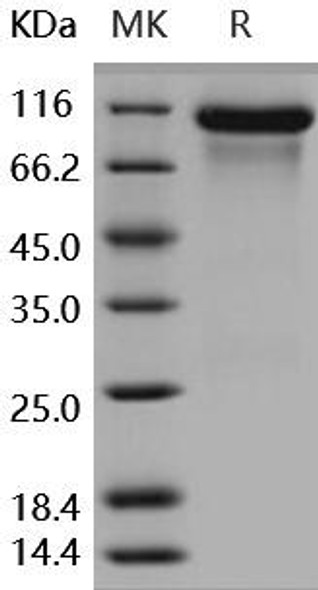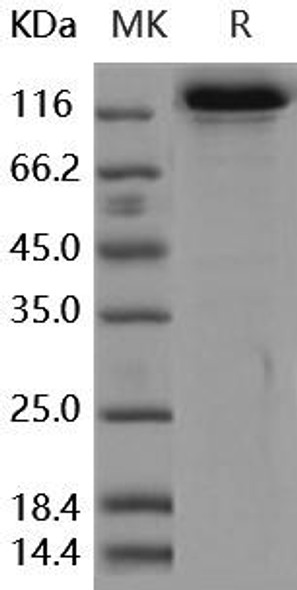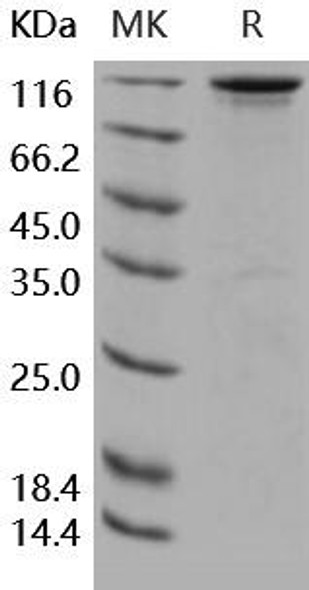Description
| Product Name: | Human ErbB3 Recombinant Protein |
| Product Code: | RPPB2509 |
| Size: | 10µg |
| Species: | Human |
| Target: | ErbB3 |
| Synonyms: | Tyrosine Kinase ErbB-3, sf9, ErbB3 sf9, Receptor tyrosine-protein kinase erbB-3, ERBB3, Proto-oncogene-like protein c-ErbB-3, Tyrosine kinase-type cell surface receptor HER3, HER3, Receptor tyrosine-protein kinase erbB-3 isoform, c-erbB-3, ErbB-3, erbB3-S, LCCS2, MDA-BF-1, p180-ErbB3, p45-sErbB3, p85-sErbB3. |
| Source: | Sf9 Insect cells |
| Physical Appearance: | Sterile Filtered colorless solution. |
| Formulation: | ErbB3 protein solution (0.25mg/ml) contains Phosphate Buffered Saline (pH 7.4) and 10% glycerol. |
| Stability: | Store at 4°C if entire vial will be used within 2-4 weeks. Store, frozen at -20°C for longer periods of time.�For long term storage it is recommended to add a carrier protein (0.1% HSA or BSA).�Avoid multiple freeze-thaw cycles. |
| Purity: | Greater than 90.0% as determined by SDS-PAGE. |
| Amino Acid Sequence: | SEVGNSQAVC PGTLNGLSVT GDAENQYQTL YKLYERCEVV MGNLEIVLTG HNADLSFLQW IREVTGYVLV AMNEFSTLPL PNLRVVRGTQ VYDGKFAIFV MLNYNTNSSH ALRQLRLTQL TEILSGGVYI EKNDKLCHMD TIDWRDIVRD RDAEIVVKDN GRSCPPCHEV CKGRCWGPGS EDCQTLTKTI CAPQCNGHCF GPNPNQCCHD ECAGGCSGPQ DTDCFACRHF NDSGACVPRC PQPLVYNKLT FQLEPNPHTK YQYGGVCVAS CPHNFVVDQT SCVRACPPDK MEVDKNGLKM CEPCGGLCPK ACEGTGSGSR FQTVDSSNID GFVNCTKILG NLDFLITGLN GDPWHKIPAL DPEKLNVFRT VREITGYLNI QSWPPHMHNF SVFSNLTTIG GRSLYNRGFS LLIMKNLNVT SLGFRSLKEI SAGRIYISAN RQLCYHHSLN WTKVLRGPTE ERLDIKHNRP RRDCVAEGKV CDPLCSSGGC WGPGPGQCLS CRNYSRGGVC VTHCNFLNGE PREFAHEAEC FSCHPECQPM EGTATCNGSG SDTCAQCAHF RDGPHCVSSC PHGVLGAKGP IYKYPDVQNE CRPCHENCTQ GCKGPELQDC LGQTLVLIGK THLTRSPKSC DKTHTCPPCP APELLGGPSV FLFPPKPKDT LMISRTPEVT CVVVDVSHED PEVKFNWYVD GVEVHNAKTK PREEQYNSTY RVVSVLTVLH QDWLNGKEYK CKVSNKALPA PIEKTISKAK GQPREPQVYT LPPSRDELTK NQVSLTCLVK GFYPSDIAVE WESNGQPENN YKTTPPVLDS DGSFFLYSKL TVDKSRWQQG NVFSCSVMHE ALHNHYTQKS LSLSPGKHHH HHH |
ErbB3, also called Her3 (human epidermal growth factor receptor 3), is a type I membrane glycoprotein that is a member of the ErbB family of tyrosine kinase receptors. ErbB family members serve as receptors for the epidermal growth factor (EGF) family of growth factors. Among ErbB family members, ErbB3 is unique in that it contains a defective kinase domain. ErbB3 is expressed in keratinocytes, melanocytes, skeletal muscle cells, embryonic myoblasts and Schwann cells. Monomeric ErbB3 serves as a low affinity receptor for the heregulins (HRG). ErbB3 can induce specific antibody production in vivo, hence to inhibit tumor cell growth. ErbB-3 can be used to treat early, medium and advanced or post-operative breast cancer with over-expression of ErbB2. According to its mechanism of action, ErbB3 is classified as a therapeutic for cancer.
ErbB3 Human Recombinant�produced in Sf9 Baculovirus cells is a single, glycosylated polypeptide chain containing 863 amino acids (20-643 a.a.) and having a molecular mass of 95.6kDa (Migrates at 100-150kDa on SDS-PAGE under reducing conditions).ErbB3 is expressed with a 239 amino acid hIgG-His�tag at C-Terminus and purified by proprietary chromatographic techniques.
| UniProt Protein Function: | HER3: a receptor tyrosine kinase of the EGFR family. Binds and is activated by neuregulins and NTAK. Can form homodimers or ErbB-2/ErbB-3 heterodimers. Kinase domain lacks activity but heterodimerizes with other EGFRs to transduce growth signals. May be required for HER2 activity. Elevated expression in breast and other tumors is indicative of poor outcome. A secreted form is expressed in metastatic prostate cancer Two alternatively spliced isoforms have been described. |
| UniProt Protein Details: | Protein type:Oncoprotein; Kinase, protein; Protein kinase, tyrosine (receptor); Protein kinase, TK; Membrane protein, integral; EC 2.7.10.1; TK group; EGFR family Chromosomal Location of Human Ortholog: 12q13 Cellular Component: extracellular space; basolateral plasma membrane; integral to plasma membrane; apical plasma membrane; plasma membrane; receptor complex; lateral plasma membrane Molecular Function:identical protein binding; protein binding; transmembrane receptor activity; protein homodimerization activity; protein heterodimerization activity; protein-tyrosine kinase activity; growth factor binding; protein tyrosine kinase activator activity; ATP binding Biological Process: epidermal growth factor receptor signaling pathway; phosphoinositide 3-kinase cascade; fibroblast growth factor receptor signaling pathway; phosphoinositide-mediated signaling; nerve growth factor receptor signaling pathway; wound healing; heart development; cranial nerve development; negative regulation of cell adhesion; signal transduction; protein amino acid phosphorylation; peripheral nervous system development; negative regulation of signal transduction; regulation of cell proliferation; Schwann cell differentiation; positive regulation of phosphoinositide 3-kinase cascade; neuron apoptosis; innate immune response; negative regulation of secretion; negative regulation of neuron apoptosis; transmembrane receptor protein tyrosine kinase signaling pathway Disease: Lethal Congenital Contracture Syndrome 2 |
| NCBI Summary: | This gene encodes a member of the epidermal growth factor receptor (EGFR) family of receptor tyrosine kinases. This membrane-bound protein has a neuregulin binding domain but not an active kinase domain. It therefore can bind this ligand but not convey the signal into the cell through protein phosphorylation. However, it does form heterodimers with other EGF receptor family members which do have kinase activity. Heterodimerization leads to the activation of pathways which lead to cell proliferation or differentiation. Amplification of this gene and/or overexpression of its protein have been reported in numerous cancers, including prostate, bladder, and breast tumors. Alternate transcriptional splice variants encoding different isoforms have been characterized. One isoform lacks the intermembrane region and is secreted outside the cell. This form acts to modulate the activity of the membrane-bound form. Additional splice variants have also been reported, but they have not been thoroughly characterized. [provided by RefSeq, Jul 2008] |
| UniProt Code: | P21860 |
| NCBI GenInfo Identifier: | 54792102 |
| NCBI Gene ID: | 2065 |
| NCBI Accession: | NP_001005915.1 |
| UniProt Secondary Accession: | P21860,Q9BUD7, A8K6L6, B4DIK7, B4DV32, E9PDT8, |
| UniProt Related Accession: | P21860 |
| Molecular Weight: | 148,098 Da |
| NCBI Full Name: | receptor tyrosine-protein kinase erbB-3 isoform s |
| NCBI Synonym Full Names: | v-erb-b2 erythroblastic leukemia viral oncogene homolog 3 (avian) |
| NCBI Official Symbol: | ERBB3�� |
| NCBI Official Synonym Symbols: | HER3; LCCS2; ErbB-3; c-erbB3; erbB3-S; MDA-BF-1; c-erbB-3; p180-ErbB3; p45-sErbB3; p85-sErbB3�� |
| NCBI Protein Information: | receptor tyrosine-protein kinase erbB-3; proto-oncogene-like protein c-ErbB-3; tyrosine kinase-type cell surface receptor HER3 |
| UniProt Protein Name: | Receptor tyrosine-protein kinase erbB-3 |
| UniProt Synonym Protein Names: | Proto-oncogene-like protein c-ErbB-3; Tyrosine kinase-type cell surface receptor HER3 |
| Protein Family: | Receptor tyrosine-protein kinase |
| UniProt Gene Name: | ERBB3�� |
| UniProt Entry Name: | ERBB3_HUMAN |










